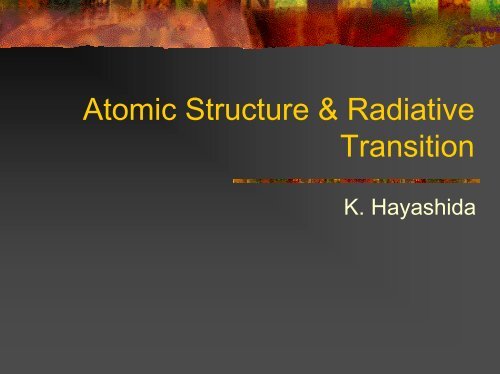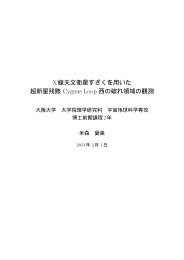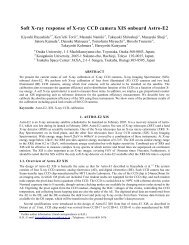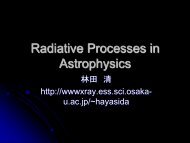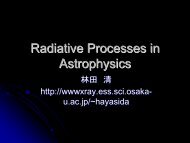Atomic Structure, Radiative Transition
Atomic Structure, Radiative Transition
Atomic Structure, Radiative Transition
Create successful ePaper yourself
Turn your PDF publications into a flip-book with our unique Google optimized e-Paper software.
Bohr Model• E=-Z 2 /n 2 BohrModel• mv 2 /re 2 Z/r 2• mvr2π=nh• λ=p/hn 2πr
• n• ~a 0 )p,ds<strong>Radiative</strong> Processes, byRybicki & Lightman
• H 2s(l=0)2p(l=1)• j• H 2p(j=1/2)2p(j=3/2)• j=1/2• 2s2p• 2s• H 2 • • He•
Fine <strong>Structure</strong>sin the Energy Levels of H-atom• =e 2 /2εhc~1/137• Spin-Orbit Interaction (L-S coupling)• (j• Relativistic EffectII,• 2⎡ α ⎛ 1 3 ⎞⎤En,j= En⎢1+n⎜ − ⎥j+1/2 4n⎟⎣ ⎝⎠⎦
Spectroscopic Terms • S+1• L 0,1,2,…S,P,D,….• J• Parity odd OParityL J,1,1,1 11 0 1 2S S P D P
(Hyper) Fine <strong>Structure</strong>s in EnergyLevels of HII,J
H-likeAtoms• s r=0• • II,
Two-electron Systems Pauli exclusion principle2 2ψ( q , q ) = ψ( q , q )1 2 2 1ψ ( q , q ) =+ ψ( q , q ) ψ( q , q ) =−ψ( q , q ) 1 2 2 1 1 2 2 1⇔ ψ( q , q ) = φ ( q ) φ ( q ) 1 2 a 1 b 2φ ( q ) φ ( q ) = φ ( q ) φ ( q ) = 0a 1 a 2 a 2 a 1 φ ( q ) φ ( q ) =−φ ( q ) φ ( q ) a 1 a 2 a 2 a 1
Symmetry vs Anti-symmetry{ }{ } ψ ( r, r ) = 1/ 2 φ ( r) φ ( r ) + φ ( r ) φ ( r)s 1 2 A 1 B 2 A 2 B 1 ψ ( r, r ) = 1/ 2 φ ( r) φ ( r ) −φ ( r ) φ ( r)a 1 2 A 1 B 2 A 2 B 1
Triplet Singlet{ }{ } χ = αα 1/ 2 α β α β , β βsS=1⇒ χ = 1/ 2 αβ α βaS=0⇒1• 2• 3 S=1 • S=0
Exchange EnergyH = e / rH = ϕH ϕdVdV = J ± K∫∫12 12 1 2 12 12212 12( + ϕ −ϕJ = φ ( r) φ ( r ) H φ ( r) φ ( r ) dVdV∫∫12 A 1 B 2 12 A 1 B 2 1 2K = φ ( r ) φ ( r ) H φ ( r ) φ ( r ) dV dV∫∫12 B 1 A 2 12 A 1 B 2 1 2 K > 012• 3
H 2 • K 12
He-atomII,
Semi-Classical Theory of<strong>Radiative</strong> <strong>Transition</strong>sr r1/22 2 4H = ⎡( cp eA)m c ⎤⎣− +⎦+ eφnonrelativistic limit, Coulomb gauger 2 2 2p e r r e AH = − A⋅ p+22m mc 2mc3epA / mc3η ≡ ≈ ( n2 2 pha0) >> 1 ( eA/2mc0 1 0 1H = H + HH H H0φ=Ek k k∑φψ () t = a () t φ exp( −iE t/ h)k k k
<strong>Transition</strong> Probabilityw=4πh TH( ω )1fi 2 fi fiT1 −1 1 iωt'fiωfi≡ π ∫ fi0H ( ) (2 ) H ( t') e dt'2E1 * 1 3f− EiHfi() t ≡∫φf H φid x,ωfi≡hikrArt ( , ) = Ate ( ) ...2 2( )24 e j ωrπrrfi ik ⋅wfi= f e l ⋅∑∇2 2jimc ωfir r r ll
Dipole Approximation∫rφ e I d xr r* ik ⋅3f⋅ ∇jφir r rik ⋅r 1 r r 2e = 1 + ik ⋅ + ( ik⋅ ) + ...2rd ≡ e ∑jj∑24πr r 2wfi = ( l ⋅d) ( )2fij ωfih c24π2 wfi = d ( )2 fij ωfih c•
Einstein Coefficients andOscillator Strengthwlu=B Jluνul432π2B = d j( ω ), B B3chlu 2 ul ul ul=lu4 3πνul364 dulAul=3chOscillator Strengthf2 24πeclassicalB = f = B fhνmclu lu lu luul2lu
Selection Rules• Dipole0(forbidden) (allowed)• (selection rule)• ∆l=1,∆m=0, 1• ∆S=0,∆L=0, 1, ∆J=0, 1 (except J=0 toJ=0)


